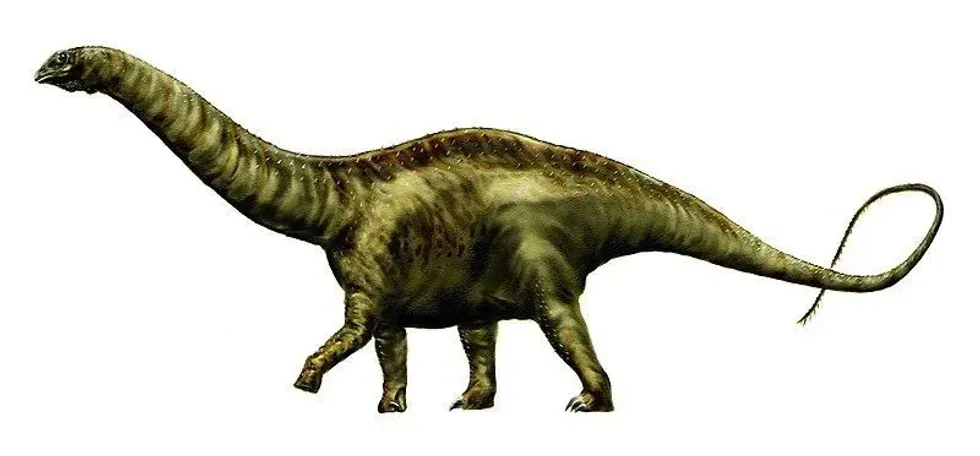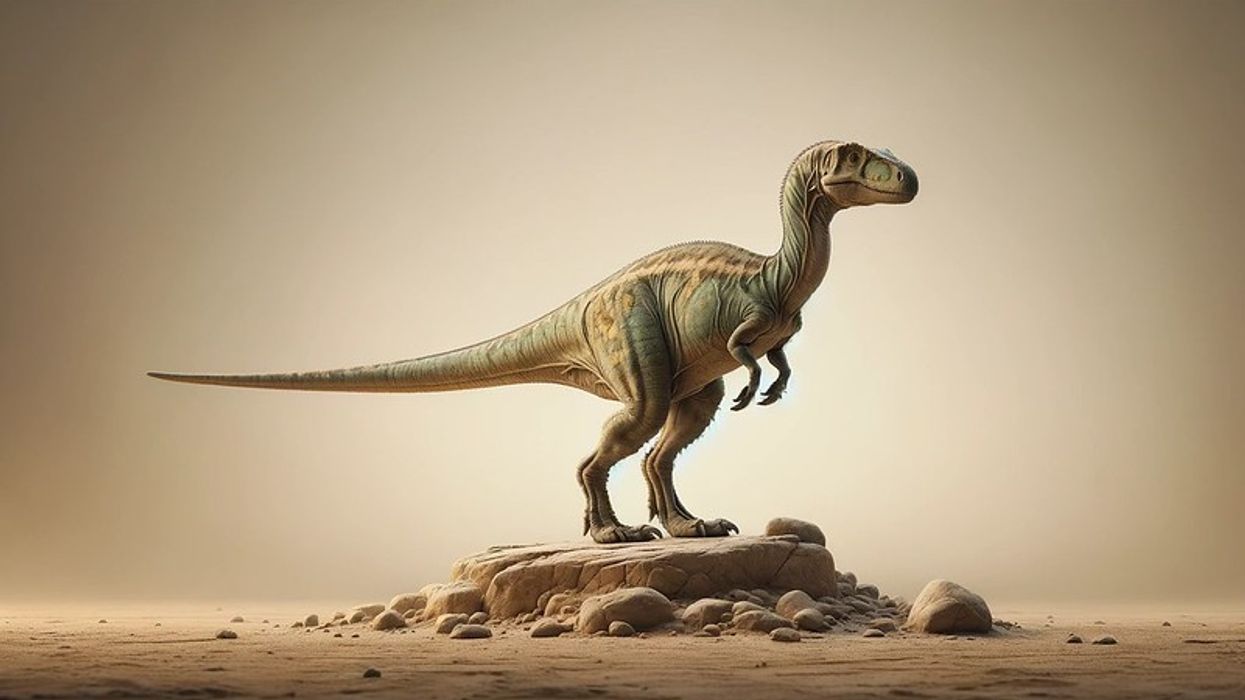The genus Albalophosaurus consists of a ceratopsian ornithischian dinosaur first described in 2009. It was a herbivore dinosaur that lived in the Early Cretaceous Period and was found exclusively in Asia, mainly Japan.
It was not common to find dinosaur remains in Japan as most fossils are discovered in other parts of the world.
This new ornithischian dinosaur, type species - Albalophosaurus yamaguchiorum, was first discovered in 1997 with the help of remains found by Yoshinori Kobayashi from the Kuwajima Formation of central Japan.
The species Albalophosaurus yamaguchiorum discovered was described on the basis of a lower jaw and partial skull remains recovered from the Lower Cretaceous Kuwajima Formation of central Japan. The genus Albalophosaurus also has a meaning of white crest lizard.
The remains found in 1997 (SBEI 176) included cranial bones from an incomplete, disarticulated skull and left lower jaw. These fossil remains were thought to be part of a single individual Albalophosaurus dinosaur.
The name Albalophosaurus is derived from the Latin word Albus which means 'white' and the Greek word lophos which means 'crest'. This name is in reference to Mount Hakusan which has a snow-covered crest.
The species name yamaguchiorum was given to pay tribute to Ichio Yamaguchi and Mikiko Yamaguchi, who discovered many fossils from the site of Mount Hakusan.
The exact age is unknown, however, the Kuwajima Formation is known to have formed during the Early Cretaceous period. Recent studies have now shown the age of the Kuwajima Formation is probably Valanginian—Hauterivian.
This genus represents only the third taxon of dinosaurs discovered in Japan and this discovery gives us a close view of the diversity of east Asian dinosaur faunas during the Early Cretaceous. The species Albalophosaurus yamaguchiorum of Japan is estimated to be around 3 ft (1 m) in length and around 22 lb (10 kg) in weight.
However, these values might not be accurate, the lack of fossil being the primary reason why scientists and researchers are not able to estimate the weight and size of the dinosaur species.
For more relatable content, check out these Berberosaurus facts and Hoplitosaurus fun facts for kids.
Albalophosaurus Interesting Facts
How do you pronounce 'Albalophosaurus'?
The pronunciation of the word Albalophosaurus is 'Al-bah-low-foe-sore-us'. The word also means white-crested-lizard.
What type of dinosaur was an Albalophosaurus?
The dinosaurs in the genus Albalophosaurus were a herbivorous terrestrial species living in Japan of Asia. It was a ceratopsian ornithischian dinosaur found in the early cretaceous period.
In which geological period did the Albalophosaurus roam the earth?
The Albalophosaurus dinosaur is known from the Early Cretaceous Epoch. The remains of a single individual were found in 1997 in Japan.
When did the Albalophosaurus become extinct?
Going by the historical period of these dinosaurs, they would have been living on the earth and roaming the lands of Japan, Asia around 140 million years ago to 130 million years ago.
Where did an Albalophosaurus live?
The dinosaurs were known to live in Japan in Asia, acc0rding to the fossil found of the white-crested lizard. A paleontologist from Japan named Yoshinori Kobayashi discovered the first fossil in 1997 in Kuwajima Formation located in central Japan, outcropping in Hakusan in the Ishikawa Prefecture.
What was an Albalophosaurus' habitat?
The habitat of the ceratopsian dinosaur is found to be Japanese woodlands. The fossil found of the dinosaurs in those regions proves their existence in the area. The ceratopsian dinosaurs were terrestrial and were known to feed on plants and vegetation in the area.
Who did an Albalophosaurus live with?
There is no information stating the company these dinosaurs used to keep. However seeing the herbivorous nature and the small size of the ceratopsian dinosaur, it has been stated that the species probably used to live in small groups and forage together.
How long did an Albalophosaurus live?
The lifespan of the dinosaur is not known. We have very little information available for the dinosaur as not even a full Albalophosaurus skeleton has been found to date. Asia is a huge ground where many fossils have been found for different species, however, not much have been recovered from Japan.
How did they reproduce?
The reproduction information of the dinosaur is not known. We just know that the dinosaur used to lay eggs to produce offsprings. No information on the number of babies is available for the species.
Albalophosaurus Fun Facts
What did an Albalophosaurus look like?
 We've been unable to source an image of an Albalophosaurus and have used an image of an Apatosaurus instead. If you are able to provide us with a royalty-free image of an Albalophosaurus, we would be happy to credit you. Please contact us at hello@kidadl.com.
We've been unable to source an image of an Albalophosaurus and have used an image of an Apatosaurus instead. If you are able to provide us with a royalty-free image of an Albalophosaurus, we would be happy to credit you. Please contact us at hello@kidadl.com. The lack of fossil found is the main reason why we have no clear idea of the size and weight of the dinosaur species. However, it is estimated that the size was small of the herbivorous dinosaur and the skull was thickened.
It was a bipedal dinosaur found in the woodlands of Japan. To get more concrete information about this lizard, we need to wait for more fossils to be unearthed from the region.
The remains found at first was just cranial bones from an incomplete, disarticulated skull, and also a left lower jaw was found. A unique suite of characters in the dentition, maxilla, and dentary was discovered from the fossil found.
How many bones did an Albalophosaurus have?
A full skeleton of the dinosaur has not been found till now, so the number of bones is not known. Only an incomplete skull and lower jaw have been found.
How did they communicate?
There is no information on the mode of communication of this species. Like other dinosaurs, they probably communicated by sound, touch, or by chemical methods.
How big was an Albalophosaurus?
Although it is not known completely, the size of the Albalophosaurus dinosaur is estimated to be up to 3 ft (1 m).
How fast could an Albalophosaurus move?
The speed is not known, however, seeing as the species is considered to be bipedal, they would not have been too quick.
How much did an Albalophosaurus weigh?
The estimated weight is up to 22 lb (10 kg). Without proper evidence, this data cannot be held as concrete evidence.
What were the male and female names of the species?
There is no information on different names given for the males and females of this dinosaur.
What would you call a baby Albalophosaurus?
The name given to the baby of an Albalophosaurus dinosaur is not known.
What did they eat?
Albalophosaurus dinosaurs lived in the woodlands and fed on plants and vegetation. This was a herbivorous species.
How aggressive were they?
They were probably not dangerous or aggressive.
Did you know...
The name Albalophosaurus is given in reference to the snow-covered crest of Mount Hakusan. The name itself means white crest lizard in Greek.
This ceratopsian dinosaur was only described recently in 2009 with the help of a fossil found in the Kuwajima Formation of central Japan, The area outcropping in Hakusan in the Ishikawa Prefecture. Because of the lack of marine beds containing index fossils, the accurate age of the strata is not known.
However, the Kuwajima Formation is known to have formed in the Early Cretaceous period. Although the exact age is not certain, the age of the Kuwajima Formation is most likely Valanginian-Hauterivian.
Although the species have been described as basal ceratopsian, it does show similarity to other ornithopod dinosaurs in dental morphology. This proves that the species might have been a primitive ceratopsian dinosaur.
How to identify the Albalophosaurus?
Albalophosaurus can probably be identified by the small size and thickened skull. The dinosaur was also thought to be bipedal.
How was the Albalophosaurus discovered?
Remains of the species were found by Yoshinori Kobayashi from the Kuwajima Formation of central Japan in 1997. The fossil of a single individual consisting of cranial bones of an incomplete, disarticulated skull and left lower jaw was found and later described in 2009.
Here at Kidadl, we have carefully created lots of interesting family-friendly dinosaur facts for everyone to discover! Learn more about some other creatures from our Ichthyovenator facts, or Zuniceratops facts for kids.
You can even occupy yourself at home by coloring in one of our free printable Albalophosaurus coloring pages.
*We've been unable to source an image of an Albalophosaurus and have used an image of an Apatosaurus instead. If you are able to provide us with a royalty-free image of an Albalophosaurus, we would be happy to credit you. Please contact us at hello@kidadl.com.










